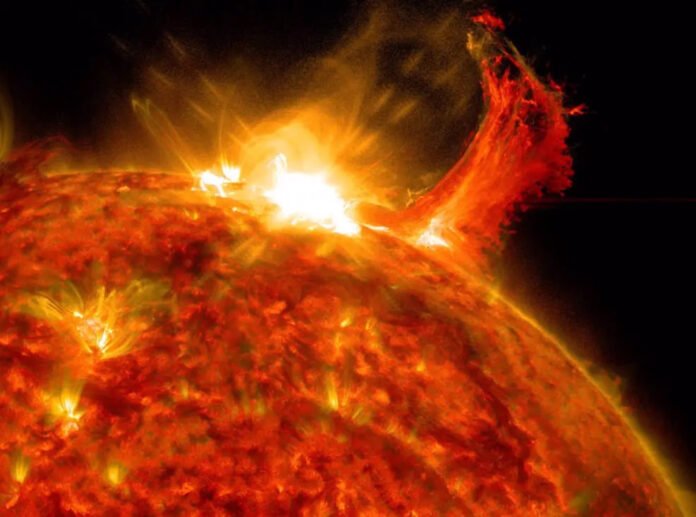A rare radiation storm is looming over the Earth this week, posing potential risks to technology and satellite communication systems. R. A. Singh, a retired joint director and geography expert from Teria, Uttar Pradesh, has warned of the heightened likelihood of a radiation storm hitting the planet. This alarming prediction comes in the wake of the recent detection of a coronal mass ejection (CME), a powerful burst of solar wind and magnetic fields, originating from the Sun.
The potential impact of a radiation storm raises concerns about its effects on various technological systems, including satellite communication, GPS navigation, and power grids. These systems are vulnerable to disruptions caused by high levels of radiation and electromagnetic interference, which can lead to communication failures, satellite malfunctions, and power outages.
In light of the impending threat, it is essential for individuals and organizations to take proactive measures to mitigate the potential risks associated with a radiation storm. Here are some tips to stay safe:
- Stay Informed: Keep abreast of the latest updates and advisories from reliable sources, such as government agencies and meteorological organizations, regarding the potential impact of the radiation storm. Stay tuned to weather forecasts and alerts for guidance on how to prepare and respond to the situation.
- Limit Outdoor Activities: Minimize exposure to radiation by reducing outdoor activities, especially during peak periods of solar activity. If you must be outdoors, seek shelter in a sturdy building or vehicle to minimize exposure to radiation.
- Protect Electronic Devices: Safeguard electronic devices and equipment from potential damage or interference caused by radiation. Consider unplugging sensitive devices and appliances, such as computers, televisions, and telecommunications equipment, to prevent damage from power surges or electromagnetic disturbances.
- Have Emergency Supplies: Prepare an emergency kit containing essential supplies, such as food, water, first aid supplies, and flashlights, in case of power outages or disruptions to essential services. Be ready to evacuate if necessary and have a plan in place for contacting loved ones and emergency services.
- Follow Safety Guidelines: Adhere to safety guidelines and instructions issued by authorities in the event of a radiation storm. Stay indoors, away from windows and doors, and avoid using electrical appliances or running water during the height of the storm.
As the Earth braces for the potential impact of a radiation storm, scientists and researchers are closely monitoring solar activity and analyzing data to assess the likelihood and severity of the event. Coronal mass ejections (CMEs) are powerful eruptions of plasma and magnetic fields from the Sun’s corona, capable of releasing vast amounts of energy and radiation into space. When directed towards Earth, these solar storms can interact with our planet’s magnetic field, producing geomagnetic disturbances and radiation hazards.
The effects of a radiation storm can vary depending on factors such as the intensity and duration of the solar event, as well as the Earth’s magnetic field strength and atmospheric conditions. While most radiation from solar storms is absorbed by the Earth’s atmosphere and poses little risk to human health, high-altitude flights and space missions may experience increased radiation exposure during geomagnetic storms.
In addition to the potential impacts on technology and communication systems, radiation storms can also affect space weather and atmospheric conditions. Solar radiation can ionize the Earth’s upper atmosphere, leading to enhanced auroral activity and geomagnetic disturbances known as magnetic storms. These phenomena can disrupt radio communications, navigation systems, and satellite operations, posing challenges for air traffic control, military operations, and space exploration.
In recent years, advances in space weather forecasting and monitoring have improved our ability to predict and mitigate the effects of solar storms. Space weather forecasters use data from satellites, ground-based observatories, and computer models to track solar activity and assess the potential impact on Earth. By providing early warnings and alerts, these forecasting efforts help governments, businesses, and individuals prepare for and respond to solar storms.
Despite these advancements, the threat of solar storms remains a concern for scientists and policymakers, particularly as society becomes increasingly reliant on technology and interconnected systems. Vulnerabilities in critical infrastructure, such as power grids, telecommunications networks, and satellite constellations, highlight the need for continued investment in space weather research and preparedness efforts.
In addition to technological safeguards, individuals can also take steps to protect themselves and their communities from the potential effects of a radiation storm. Creating emergency plans, stockpiling essential supplies, and staying informed about space weather forecasts are crucial steps in mitigating the risks associated with solar storms.
As the Earth prepares for the possibility of a radiation storm this week, it serves as a reminder of the dynamic and interconnected nature of our solar system. By understanding and respecting the power of the Sun and its influence on our planet, we can better prepare for and adapt to the challenges posed by solar storms and other space weather phenomena. Through collaboration, innovation, and vigilance, we can safeguard our world and ensure a resilient and secure future for generations to come.

